July 1969 – Apollo 11 astronauts Neil A. Armstrong, Edwin E. “Buzz” Aldrin, and Michael Collins were ready to embark on their historic journey to fulfill President John F. Kennedy’s goal to land a man on the Moon and return him safely to the Earth. Arriving at the Kennedy Space Center (KSC) after the Fourth of July holiday weekend, they busied themselves with final training for the mission. All three piloted aerobatic flights aboard T-38 Talon training aircraft, spent time reviewing their flight plan, Armstrong and Aldrin trained in the Lunar Module (LM) simulator while Collins did the same in the Command Module (CM) simulator, Aldrin experienced one-sixth gravity during KC-135 parabolic flights, and Armstrong flew helicopters to hone his skills for piloting the LM to the lunar surface. Two days before launch the trio held a brief news conference, with reporters asking any final questions via a television link up – NASA wanted to minimize the astronauts’ exposure to people to prevent any illnesses that might delay the mission or cause any problems during the flight. The preliminary countdown for launch began on July 11 and the terminal countdown three days later.



Four days before launch, Apollo 11 astronauts (left to right) Armstrong, Aldrin, and Collins arrive for work at KSC for some of their final simulator runs.


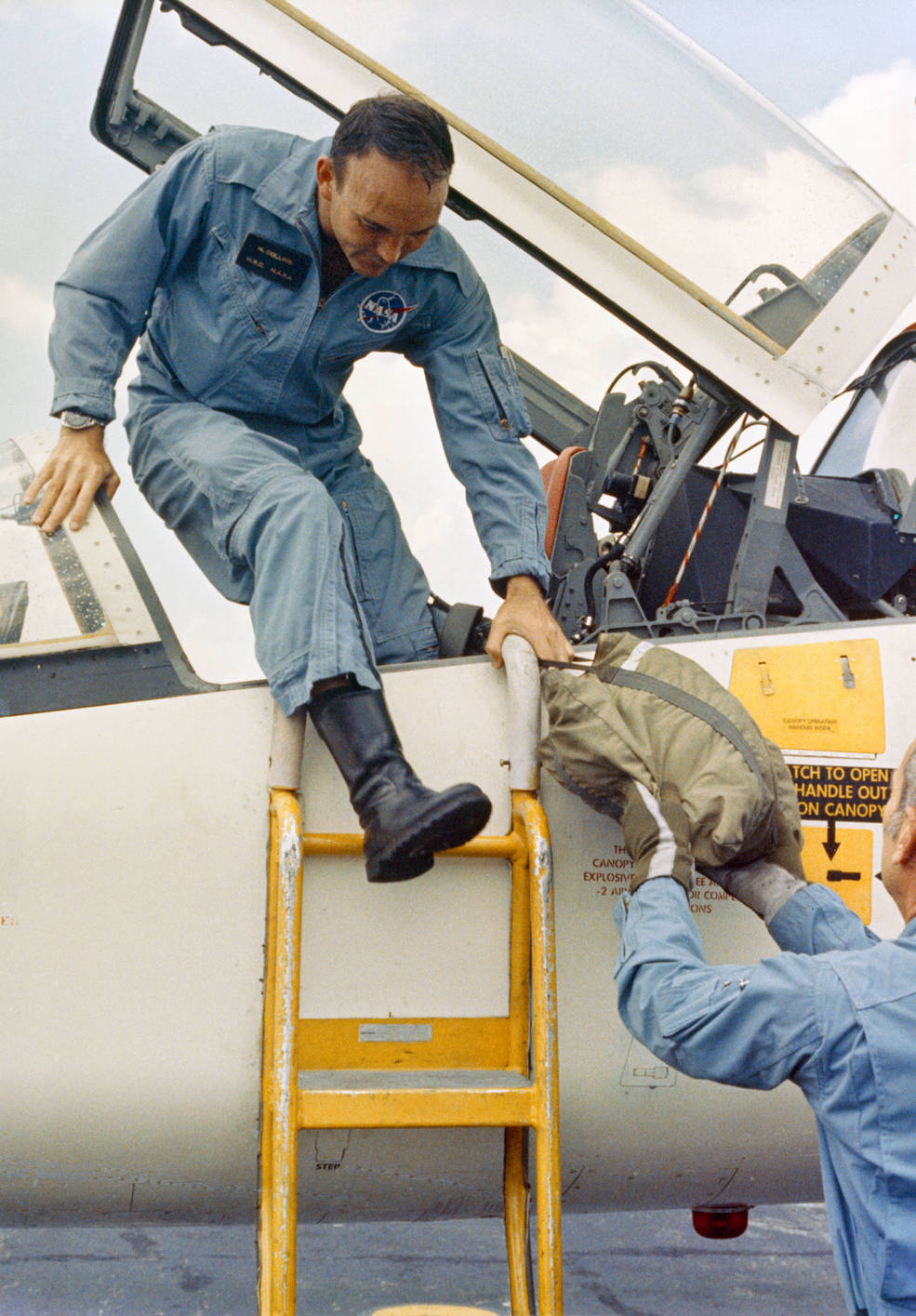
Left: Armstrong and Aldrin conduct a simulation in the LM simulator. Middle: Aldrin during a 1/6-g KC-135 training session. Right: Collins exiting a T-38 aircraft after completing an aerobatic training flight.
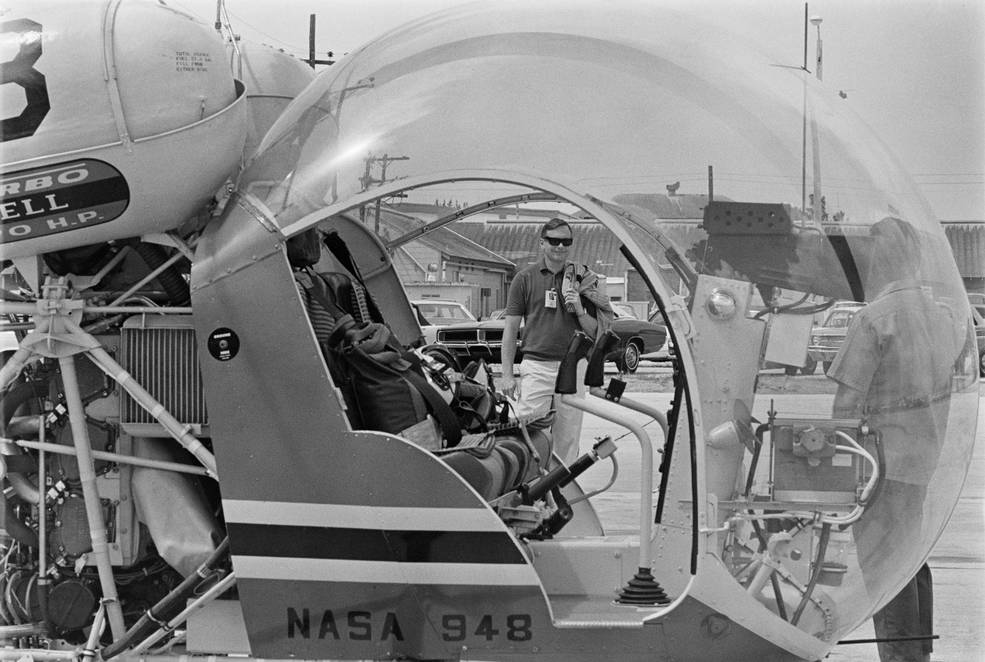

Left: Apollo 11 Commander Armstrong arrives for helicopter training to sharpen
his skills for the Moon landing. Right: Armstrong during an EVA training session,
rehearsing his first step on the Moon.


Left: Apollo 11 astronauts (left to right) Aldrin, Collins, and Armstrong review their mission’s flight plan a few days before launch. Right: Apollo 11 astronauts (left to right) Aldrin, Armstrong, and Collins during the July 14 press conference at KSC.
Between July 7 and 9, the Apollo 11 prime recovery ship USS Hornet conducted nine Simulated Recovery Exercises (SIMEX) in local Hawaiian waters, with US Navy Frogmen as stand-ins for the astronauts wearing Biological Isolation Garments (BIG), before returning to Pearl Harbor. Once in port, the rest of the NASA personnel and press corps came aboard, as did the Frogmen who had been given a few days of shore leave. On July 12, Hornet slipped her moorings and sailed from Pearl for her first on duty station to support a possible launch abort. Should anything have gone wrong during the first hours of the mission, Apollo 11 would have made an emergency splashdown in the Pacific Ocean about 1,600 miles southwest of Hawaii. Hornet crossed the equator on July 15, with the usual onboard celebrations, arriving at the abort location about five hours before the Apollo 11 launch. Nine more SIMEXs were completed, including a challenging nighttime recovery exercise. Hornet remained at this duty station until Apollo 11 was safely on its way to the Moon, then headed north toward the nominal end of mission splashdown area about 1,200 miles southwest of Honolulu and 450 miles south of Johnston Island.

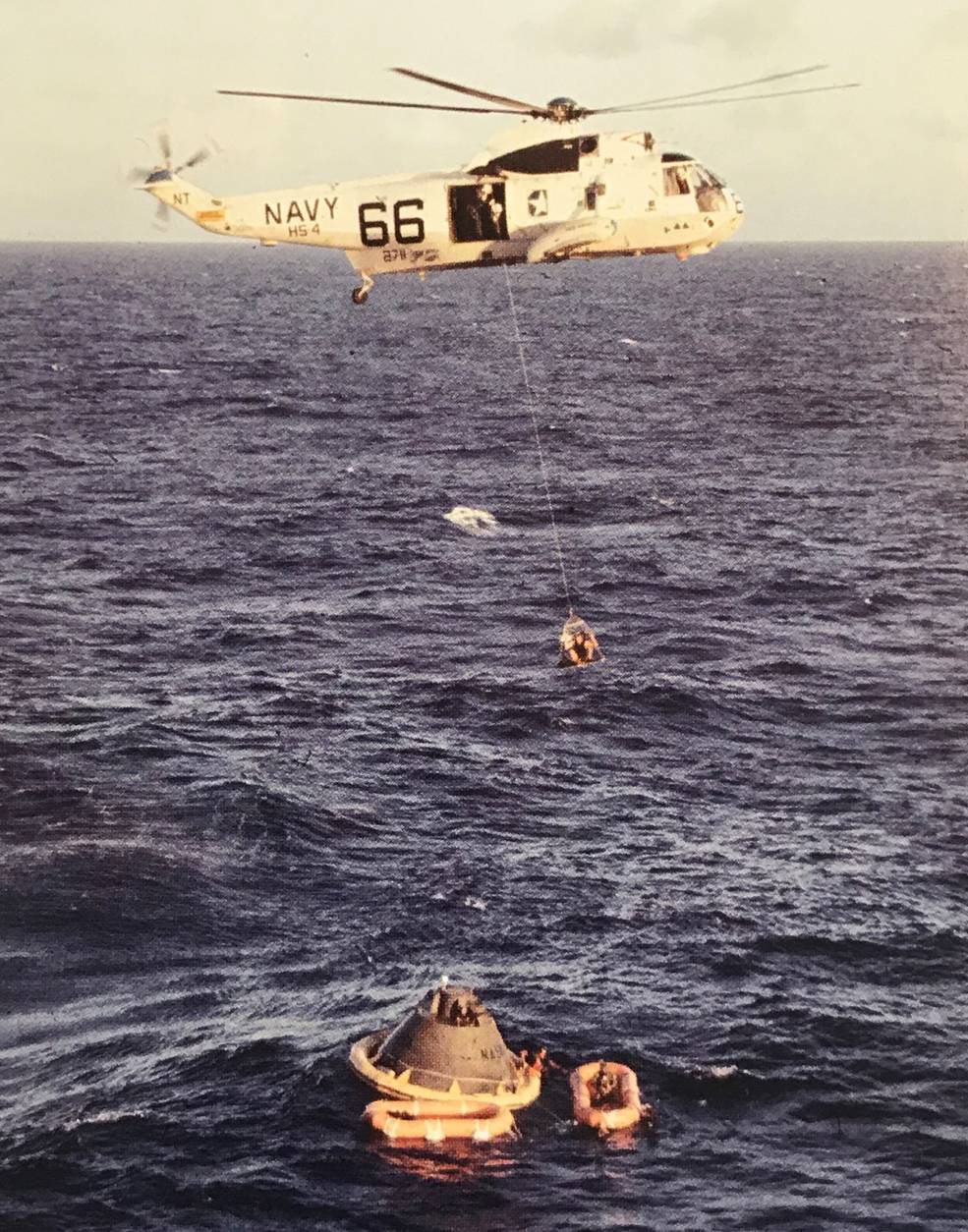

SIMEX operations with USS Hornet. Left: USS Hornet approaching the boilerplate Apollo CM as swimmers jump from the recovery helicopter. Middle: Swimmer being hoisted onto a recovery helicopter. Right: Swimmers drying their BIG suits
on Hornet’s deck.
NASA personnel aboard Hornet were rehearsing some of the activities associated with the quarantine of the crew after splashdown to prevent back contamination of Earth with any possible lunar micro-organisms. According to the plan, the designated decontamination swimmer, Lt. Clarence J. “Clancy” Hatleberg of Underwater Demolition Team-11 who in May had trained with the Apollo 11 astronauts in the Gulf of Mexico, would briefly open the CM hatch after splashdown and hand them their BIGs, which they donned while still in the capsule floating in the water. Once the astronauts were out of the capsule and aboard a life raft, Hatleberg would decontaminate them and the capsule. A rescue helicopter then would hoist the astronauts aboard and fly them to the carrier. Sailors would take the helicopter below decks, and the astronauts walked to and entered the Mobile Quarantine Facility (MQF), where they remained, along with a flight surgeon and an engineer, until Hornet arrived in Hawaii. They were then flown back to Houston to continue their quarantine at the Lunar Receiving Laboratory at the Manned Spacecraft Center (MSC), now the Johnson Space Center in Houston.
The MQF was equipped with a decontamination lock to allow the transfer of lunar samples and film to the outside without breaking the biological barrier. During Hornet’s cruise to the recovery zone, John K. Hirasaki, a systems engineer with MSC’s Landing and Recovery Division, and Eugene G. Edmonds, Chief of the General Photographic Branch of the Office of Technical and Engineering Services, practiced the transfer of film canisters from inside the MQF. Hirasaki first simulated the retrieval of film from a boilerplate CM that was attached to the MQF by a temporary tunnel to maintain biological isolation. Inside the MQF, he vacuum sealed the film in plastic bags and placed them in the lock, which he flooded with sodium hypochlorite solution, a disinfectant to kill any possible pathogens. He then drained the lock and Edmonds retrieved them for packing into shipping containers. The process would be repeated on landing day, for the lunar samples as well as the film that the astronauts returned from their mission.


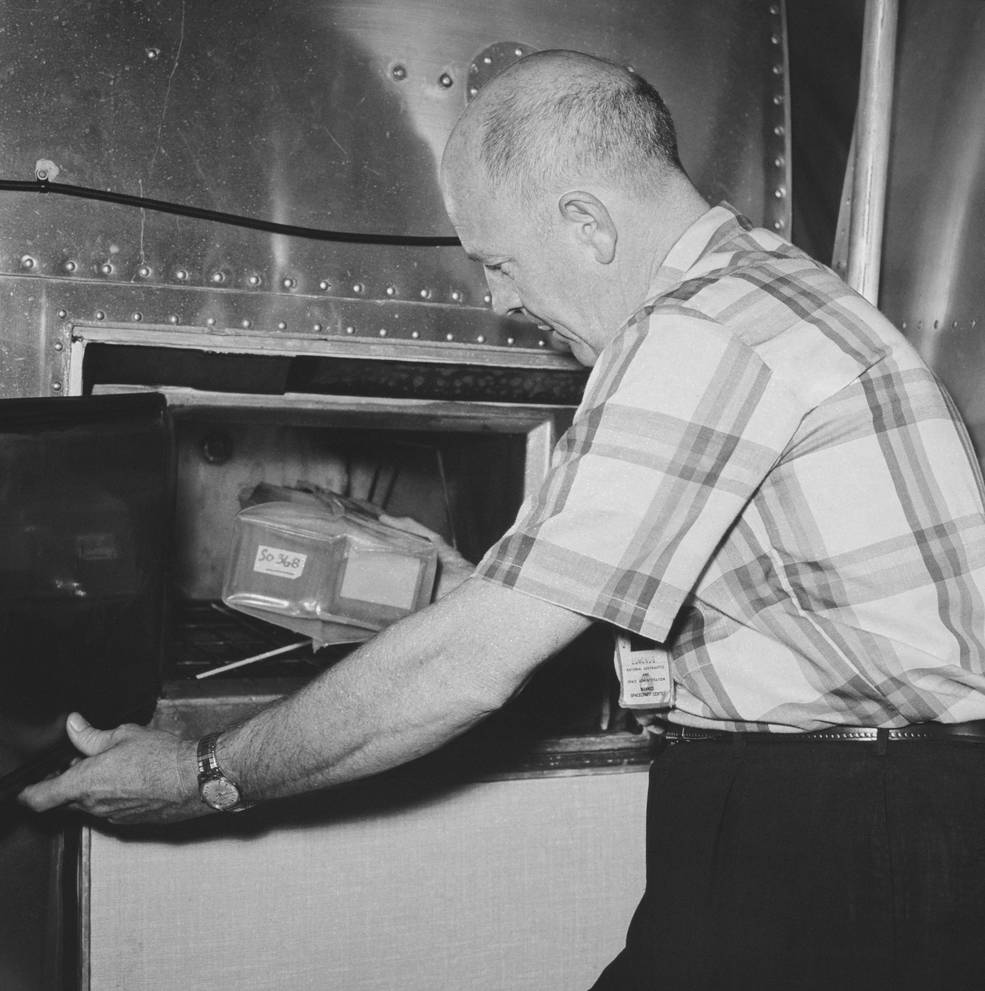

NASA personnel rehearsing transfer of film canisters from inside the MQF aboard Hornet. Left to right: Hirasaki retrieved canisters from the boilerplate CM; inside the MQF, Hirasaki sealed them in plastic bags; outside the MQF, Edmonds retrieved them from the lock; and Edmonds packed them for shipping.
While preparations for the first Moon landing mission were reaching their conclusion, NASA continued to plan for a possible Apollo 12 mission in September, should the first landing not be successful. At KSC, the Saturn V for that mission was already stacked on its Mobile Launch Platform inside the Vehicle Assembly Building. At Ellington Air Force Base near MSC, Apollo 12 Commander Charles “Pete” Conrad completed five flights in the Lunar Landing Training Vehicle (LLTV). Apollo commanders and their backups used the LLTV to simulate the flying characteristics of the LM during the last few hundred feet before touchdown.


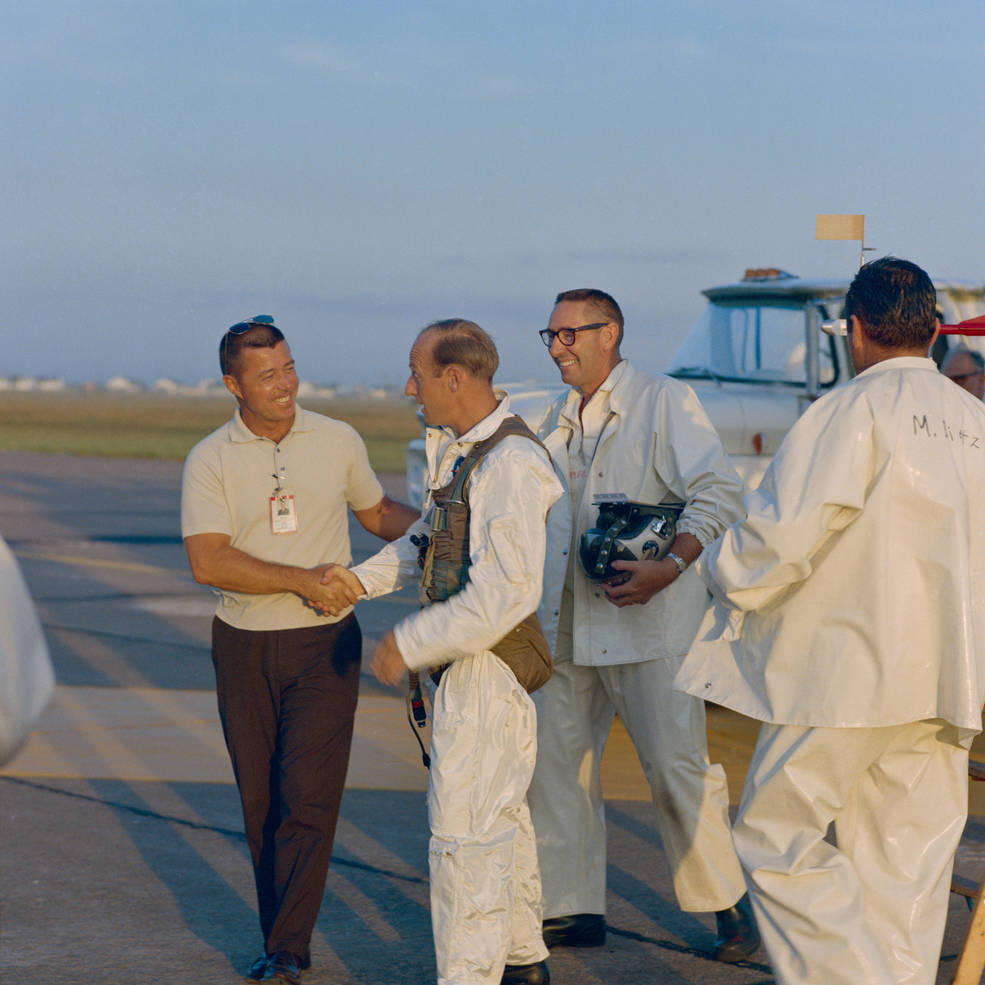
Left: Apollo 12 Commander Conrad flying LLTV-2. Middle: Conrad after completing a training flight aboard LLTV-2. Right: Conrad shaking hands with NASA pilot Bud Ream after completing an LLTV-2 training flight.
In an unusual episode of warm relations between the two superpowers still very much in competition for dominance in space, Apollo 8 astronaut Frank Borman was invited by of the Union of Soviet Societies of Friendship and the Institute of Soviet-American Relations to tour Russia. Borman and his wife Susan arrived in Moscow on July 2 for an eight-day visit. They were greeted at Sheremetievo Airport by Soviet cosmonauts Georgy T. Beregovoi, Gherman S. Titov and Konstantin P. Feoktistov, and General Nikolai P. Kamanin, Director of the Gagarin Cosmonaut Training Center in Star City. Borman became the first American astronaut to visit Star City on July 5, where he met with officials and many Soviet cosmonauts. He also met with Academician Mstislav V. Keldysh, President of the Soviet Academy of Sciences and one of the founders of the Soviet space program. That meeting would prove useful just a few days later.
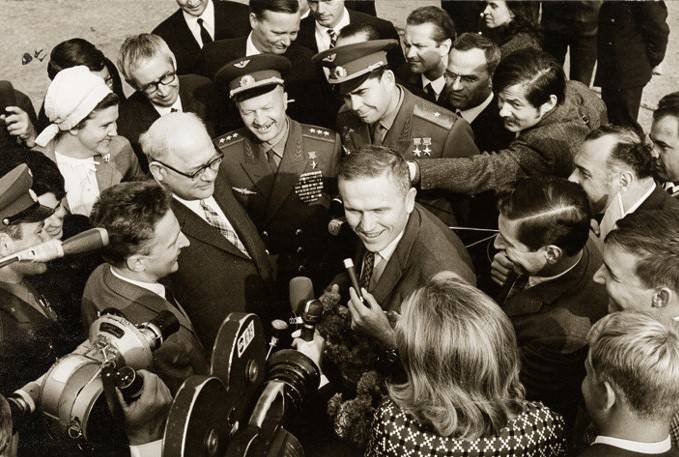

Left: Borman (at center) being greeted by dignitaries and reporters at Star City. Right: Borman (front row, second from right) posing with a group of Soviet cosmonauts at Star City. Credits: Heritage Auctions.
Goodwill gestures notwithstanding, the Soviet Union was still very much in the race to land humans on the Moon. In late June, workers at the Baykonur Cosmodrome rolled out an N-1 Moon rocket to its launch pad. With a mockup N-1 rocket on the adjacent pad for fit checks, for a few days the scene at Baykonur was impressive as two Moon rockets stood side by side. Atop the “live” rocket was a modified Soyuz spacecraft the Soviets intended to send on an unpiloted lunar orbital mission. On July 3, the 30 engines of the rocket’s first stage ignited, lighting up the midnight sky at Baykonur. For the first 10 seconds of the launch, everything appeared to be nominal but at an altitude of 100 meters, the rocket seemed to stall and began tilting to one side. The Launch Escape System’s engines fired, pulling the spacecraft’s descent module to safety but the giant rocket fell back onto its launch pad, exploding in a tremendous fireball. The failure was later attributed to a small explosion in one of the first stage’s 30 engines that rapidly engulfed multiple nearby engines. The launch pad was destroyed, the damage so severe it was readily apparent on American surveillance satellite imagery. The accident, the second following the first launch failure in February 1969, set the N-1 program back by about two years.

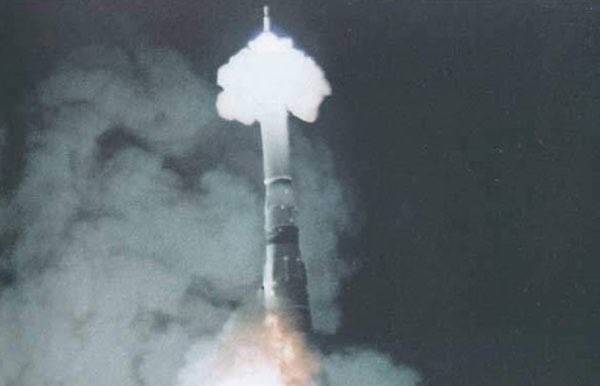

Left: Two N-1 Moon rockets on adjacent pads at Baykonur. Middle: The Launch Escape System fired to pull the lunar spacecraft free of the now-falling N-1 rocket. Right: Reconnaissance satellite image of the two N-1 launch pads at the Baykonur, with the right hand pad showing the damage from the July 3 explosion. Credits: National Photographic Interpretation Center, RKK Energiya
Undeterred by the N-1 explosion, the Soviets made one more attempt to upstage Apollo 11 – a robotic lunar sample return mission. On July 13, they launched Luna 15 toward the Moon on a Proton rocket – a previous attempt in June ended in a launch failure. Four days later, as Apollo 11 was headed toward the Moon, Luna 15 entered an elliptical lunar orbit. Concerns at NASA that Luna 15 would interfere with the Apollo 11 mission were allayed when Borman contacted Academician Keldysh – the two had met in Moscow just a few days before – who provided Luna 15’s planned trajectory to NASA, the first such exchange in Soviet-American space relations. Initially planned for a July 20 landing, Soviet controllers concerned about the ruggedness of the planned landing site in the Mare Crisium kept Luna 15 in orbit an extra day. Finally, on July 21 after 52 orbits around the Moon, Luna 15 began its descent toward the surface. By this time, Armstrong and Aldrin had already completed their walk on the Moon and were preparing to lift off to rejoin Collins in lunar orbit. But transmissions with Luna 15 ceased early, and it is estimated that it crashed at excessive speed – apparently its attitude at the time the descent engine fired was off by several degrees. In September 1970, Luna 16 completed its predecessor’s mission by returning lunar soil samples from the Mare Fecunditatis.


Left: Mockup of what Luna-15 would have looked like after a soft landing on the Moon – the brown sphere at the top of the spacecraft is the return capsule. Right: Relative locations of the Apollo 11 and Luna 15 landing sites. Credits: RKK Energiya.


























